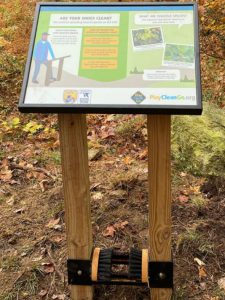Benjamin Franklin once famously said, “An ounce of prevention is worth a pound of cure.” When it comes to protecting valuable habitat, Franklin’s words take on a whole new meaning. The Washington Invasive Species Council has received funding to help protect shrub-steppe habitat from noxious weed spread and development. With support from the U.S. Forest Service, the council is giving away fifty PlayCleanGo® Boot Brush Stations with custom signs (pictured below from the vendor’s website) to install in areas around Washington’s shrub-steppe.
Boot Brushes

A boot brush is a stiff-bristled brush that is fixed in place. This preventative tool allows people to rub the bottom of their boots across the bristles, dislodging any mud, debris, and seeds. Boot brushes can prevent noxious weed seeds from being introduced into the sensitive shrub-steppe habitat, thus saving significant money down the road. These brushes have been recommended as decontamination tools in publications such as Management Strategies for Invasive Plants in Pacific Northwest Prairies, Savannas, and Oak Woodlands. The efficacy of boot brushes at removing seeds from boots has been studied, and the summary is available on the North American Invasive Species Management Association’s website.
Case Studies
This project was inspired by a similar and successful project in the Columbia River Gorge. In 2011, the Columbia Gorge Cooperative Weed Management Area received funding from the National Fish and Wildlife Foundation to survey for weeds on state and federal lands and to install twenty-five boot brushes at key trailheads in the Columbia River Gorge. After the brushes and signs were installed, various organizations then held events to educate the public about the importance of this new preventative tool. The success of this effort far exceeded the original twenty-five boot brushes, with organizations installing additional brushes as shown in this map. Today, thirty-seven boot brushes are installed at trailheads throughout the Gorge, protecting vulnerable habitat from noxious weeds. Additionally, national forests such as the Gifford Pinchot and Willamette have installed brushes and signs in their recreational areas.
The Invasive Species Council of Idaho posted about PlayCleanGo® boot brush stations recently installed on Idaho National Forest Lands. Check out the inspiring post. The Idaho council notes that the “meadows and hillsides along this trail remain free of noxious weed infestations, allowing for native wildflowers to flourish.” Moral of the story? Boot brushes work!
Even on the East Coast, land managers are recognizing the value of boot brushes! A recent article highlights a project in New York where a local nonprofit, Ausable River Association, built and installed four boot brush stations with signs at popular trailheads near the Adirondacks. The article mentions that “boot brush stations are popping up across the region as local groups realize the positive impact and significance of this type of trailhead intervention.” The Washington Invasive Species Council aims to add to this effort and showcase Washington’s dedication to preventing the spread and establishment of noxious weeds in the shrub-steppe.
Project Timeline
This project will run through January 2026. In 2024, council staff and an interagency advisory committee will select fifty sites for boot brushes after widely distributing an interest form. Twenty-five organizations then will work with council staff to customize the boot brush signs and place the order, with all brushes installed by the end of 2024. Another twenty-five organizations will receive boot brush stations and signs in 2025. Council staff will visit the sites and talk with boot brush users to inform next steps.
Check back often for updates as the project progresses!